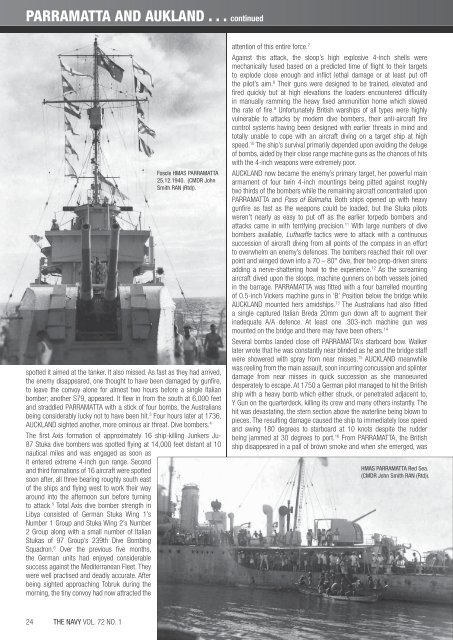JAN-MAR 2010 VOL 72 No1 - Navy League of Australia
JAN-MAR 2010 VOL 72 No1 - Navy League of Australia
JAN-MAR 2010 VOL 72 No1 - Navy League of Australia
Create successful ePaper yourself
Turn your PDF publications into a flip-book with our unique Google optimized e-Paper software.
PARRAMATTA AND AUKLAND . . . continued<br />
Foscle HMAS PARRAMATTA<br />
25.12.1940. (CMDR John<br />
Smith RAN (Rtd)).<br />
spotted it aimed at the tanker. It also missed. As fast as they had arrived,<br />
the enemy disappeared, one thought to have been damaged by gunfire,<br />
to leave the convoy alone for almost two hours before a single Italian<br />
bomber; another S79, appeared. It flew in from the south at 6,000 feet<br />
and straddled PARRAMATTA with a stick <strong>of</strong> four bombs, the <strong>Australia</strong>ns<br />
being considerably lucky not to have been hit. 3 Four hours later at 1736,<br />
AUCKLAND sighted another, more ominous air threat. Dive bombers. 4<br />
The first Axis formation <strong>of</strong> approximately 16 ship-killing Junkers Ju-<br />
87 Stuka dive bombers was spotted flying at 14,000 feet distant at 10<br />
nautical miles and was engaged as soon as<br />
it entered extreme 4-inch gun range. Second<br />
and third formations <strong>of</strong> 16 aircraft were spotted<br />
soon after, all three bearing roughly south east<br />
<strong>of</strong> the ships and flying west to work their way<br />
around into the afternoon sun before turning<br />
to attack. 5 Total Axis dive bomber strength in<br />
Libya consisted <strong>of</strong> German Stuka Wing 1’s<br />
Number 1 Group and Stuka Wing 2’s Number<br />
2 Group along with a small number <strong>of</strong> Italian<br />
Stukas <strong>of</strong> 97 Group’s 239th Dive Bombing<br />
Squadron. 6 Over the previous five months,<br />
the German units had enjoyed considerable<br />
success against the Mediterranean Fleet. They<br />
were well practised and deadly accurate. After<br />
being sighted approaching Tobruk during the<br />
morning, the tiny convoy had now attracted the<br />
attention <strong>of</strong> this entire force. 7<br />
Against this attack, the sloop’s high explosive 4-inch shells were<br />
mechanically fused based on a predicted time <strong>of</strong> flight to their targets<br />
to explode close enough and inflict lethal damage or at least put <strong>of</strong>f<br />
the pilot’s aim. 8 Their guns were designed to be trained, elevated and<br />
fired quickly but at high elevations the loaders encountered difficulty<br />
in manually ramming the heavy fixed ammunition home which slowed<br />
the rate <strong>of</strong> fire. 9 Unfortunately British warships <strong>of</strong> all types were highly<br />
vulnerable to attacks by modern dive bombers, their anti-aircraft fire<br />
control systems having been designed with earlier threats in mind and<br />
totally unable to cope with an aircraft diving on a target ship at high<br />
speed. 10 The ship’s survival primarily depended upon avoiding the deluge<br />
<strong>of</strong> bombs, aided by their close range machine guns as the chances <strong>of</strong> hits<br />
with the 4-inch weapons were extremely poor.<br />
AUCKLAND now became the enemy’s primary target, her powerful main<br />
armament <strong>of</strong> four twin 4-inch mountings being pitted against roughly<br />
two thirds <strong>of</strong> the bombers while the remaining aircraft concentrated upon<br />
PARRAMATTA and Pass <strong>of</strong> Balmaha. Both ships opened up with heavy<br />
gunfire as fast as the weapons could be loaded, but the Stuka pilots<br />
weren’t nearly as easy to put <strong>of</strong>f as the earlier torpedo bombers and<br />
attacks came in with terrifying precision. 11 With large numbers <strong>of</strong> dive<br />
bombers available, Luftwaffe tactics were to attack with a continuous<br />
succession <strong>of</strong> aircraft diving from all points <strong>of</strong> the compass in an effort<br />
to overwhelm an enemy’s defences. The bombers reached their roll over<br />
point and winged down into a 70 – 80° dive, their two prop-driven sirens<br />
adding a nerve-shattering howl to the experience. 12 As the screaming<br />
aircraft dived upon the sloops, machine gunners on both vessels joined<br />
in the barrage. PARRAMATTA was fitted with a four barrelled mounting<br />
<strong>of</strong> 0.5-inch Vickers machine guns in ‘B’ Position below the bridge while<br />
AUCKLAND mounted hers amidships. 13 The <strong>Australia</strong>ns had also fitted<br />
a single captured Italian Breda 20mm gun down aft to augment their<br />
inadequate A/A defence. At least one .303-inch machine gun was<br />
mounted on the bridge and there may have been others. 14<br />
Several bombs landed close <strong>of</strong>f PARRAMATTA’s starboard bow. Walker<br />
later wrote that he was constantly near blinded as he and the bridge staff<br />
were showered with spray from near misses. 15 AUCKLAND meanwhile<br />
was reeling from the main assault, soon incurring concussion and splinter<br />
damage from near misses in quick succession as she manoeuvred<br />
desperately to escape. At 1750 a German pilot managed to hit the British<br />
ship with a heavy bomb which either struck, or penetrated adjacent to,<br />
Y Gun on the quarterdeck, killing its crew and many others instantly. The<br />
hit was devastating, the stern section above the waterline being blown to<br />
pieces. The resulting damage caused the ship to immediately lose speed<br />
and swing 180 degrees to starboard at 10 knots despite the rudder<br />
being jammed at 30 degrees to port. 16 From PARRAMATTA, the British<br />
ship disappeared in a pall <strong>of</strong> brown smoke and when she emerged, was<br />
HMAS PARRAMATTA Red Sea.<br />
(CMDR John Smith RAN (Rtd)).<br />
24 THE NAVY <strong>VOL</strong>. <strong>72</strong> NO. 1

















